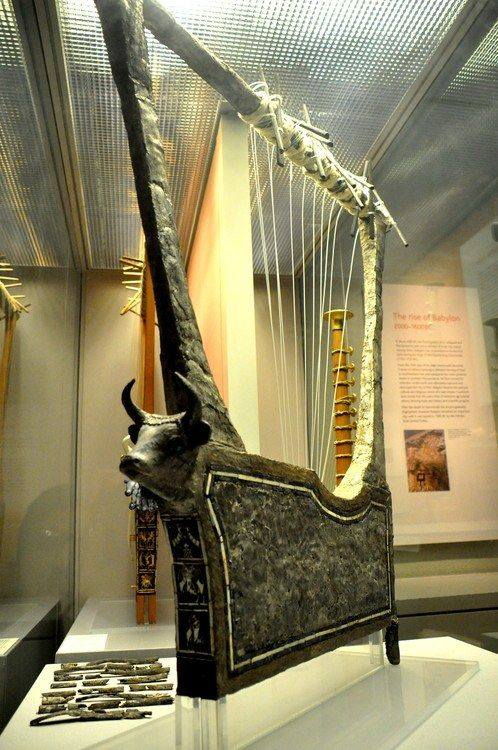The unearthing of a remarkable lyre within the “Great Death-Pit” at the Royal Cemetery of Ur, located in southern Mesopotamia (modern-day Iraq), has provided invaluable insights into the artistic and cultural sophistication of early Sumerian civilization. Dating back to the Early Dynastic period (2600–2400 BCE), this extraordinary find underscores the central role of music in religious and ceremonial life while offering a profound glimpse into the beliefs surrounding death and the afterlife in ancient Mesopotamia.
The Royal Cemetery of Ur stands as one of the most significant archaeological sites in early Mesopotamian history. This sacred burial ground contains a wealth of tombs belonging to royals and their entourages, including attendants, soldiers, and ceremonial objects. Among its most notable features is the “Great Death-Pit,” a mass grave where multiple individuals were likely sacrificed to accompany their rulers into the afterlife. The discovery of the lyre among these graves speaks volumes about its ceremonial importance, suggesting it played a role not only in life but also in rituals marking the transition to the afterlife. The mass burial reflects the depth of Mesopotamian religious beliefs, particularly the notion of an afterlife where symbols of power and status followed the deceased, including attendants and treasured artifacts such as the lyre.

The lyre itself is an extraordinary testament to Sumerian craftsmanship and artistry. Adorned with gold, silver, and lapis lazuli, it exemplifies the luxurious materials that symbolized divine power and wealth in Sumerian culture. The head of the lyre was often crafted in the shape of a bull, an animal associated with strength and fertility—qualities revered in Sumerian society. This intricate craftsmanship was not merely decorative but reflected the instrument’s immense cultural significance. The use of such precious materials indicates that the lyre held a status beyond that of a musical instrument; it was likely used in rituals, funerary ceremonies, and royal events, symbolizing both the divine and the authority of the ruling household.
The discovery of the lyre also highlights the importance of music in Sumerian religious practices. Music, as represented by the lyre, was considered a medium through which the living could communicate with the gods and the dead. This belief underscores the lyre’s presence in the “Great Death-Pit,” suggesting it was used to honor the deceased, guide their souls into the afterlife, or provide comfort on their spiritual journey. In Sumerian society, music was deeply intertwined with both entertainment and sacred rituals. The blend of exquisite artistry and the instrument’s religious significance illustrates its multifaceted role in their culture.
The beliefs surrounding the afterlife in ancient Mesopotamia are further illuminated by the “Great Death-Pit.” One of its most striking aspects was the discovery of numerous human remains, believed to be those of attendants sacrificed to accompany their ruler into the afterlife. This practice reflects a deeply ingrained belief in the enduring importance of royal status, even in death. The presence of attendants and high-value artifacts like the lyre suggests a vision of the afterlife as a continuation of earthly life, complete with the same hierarchical structures. In this context, the lyre may have served as a means of communication with the afterlife or a representation of the harmonious order that the deceased royals would oversee in their next existence.
The role of music in Sumerian death rituals sheds light on their understanding of life, death, and the transition between the two. Instruments like the lyre were believed to possess spiritual power, serving as more than mere tools for entertainment. Their symbolic association with divinity and royalty suggests they were integral to Sumerian cosmology, where kingship, religion, and the afterlife were inseparably linked. Music played a crucial role in maintaining this cosmic balance, both in life and in death.
The lyre discovered in the “Great Death-Pit” thus offers a profound window into the values, beliefs, and artistry of ancient Sumerian society. Its intricate design, rich symbolism, and the context of its burial alongside sacrificed attendants underscore the significance of both music and death rituals in Sumerian life. As a cultural artifact, the lyre continues to inspire admiration and scholarly research, shedding light on the complex world of early dynastic Mesopotamia. This world, where the boundaries between life, death, and the divine were intricately woven, reveals a civilization of remarkable depth and sophistication.
By studying such artifacts, we not only uncover the traditions and practices of ancient peoples but also gain a deeper appreciation for their legacies. The lyre from Ur exemplifies how art and culture reflect the values of a society, serving as enduring reminders of human creativity and the universal quest to understand life and death. This discovery enriches our understanding of ancient civilizations and highlights the timeless human desire to create meaning through music, ritual, and artistic expression.





